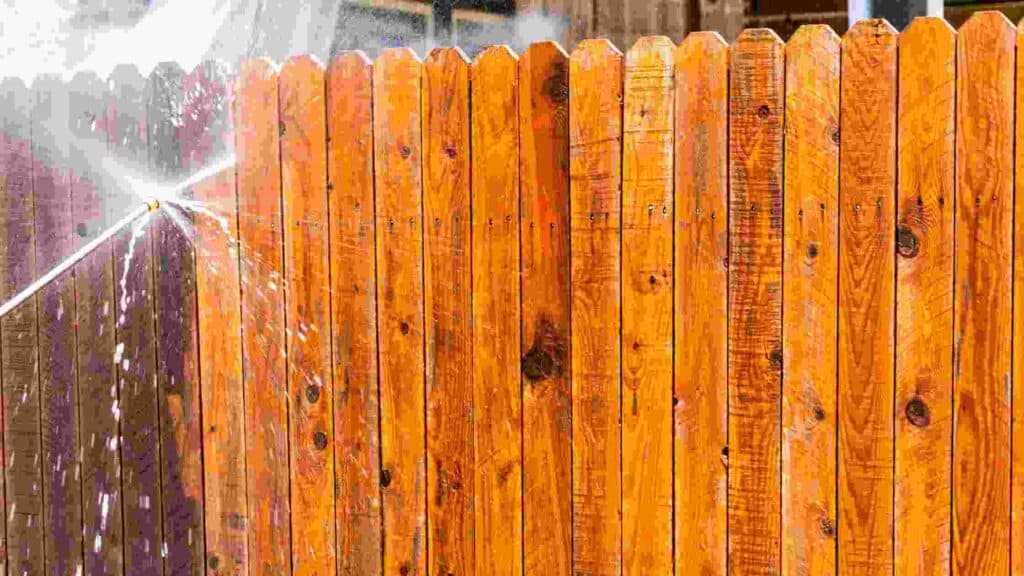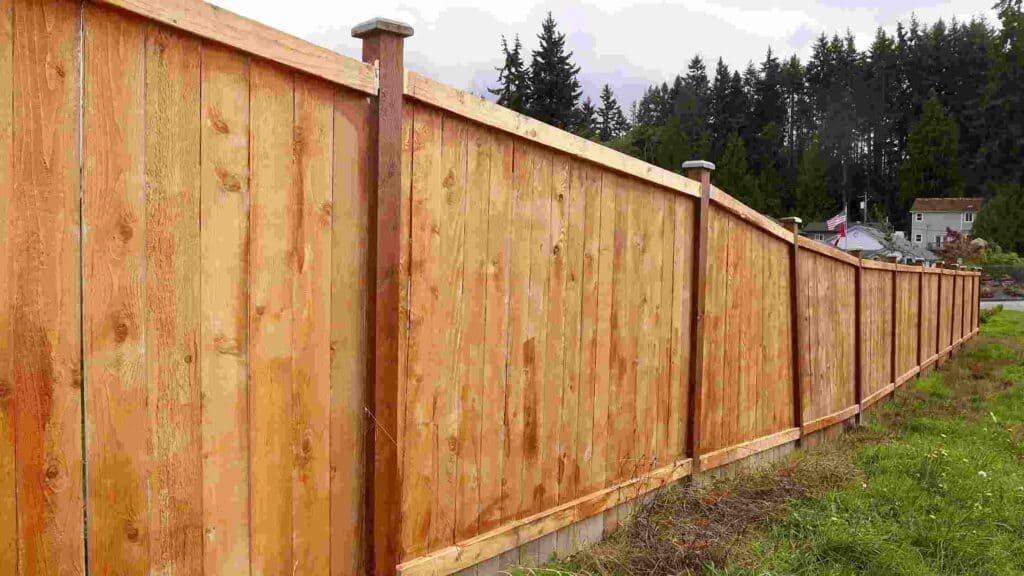When it comes to your home, a wood fence not only provides security and privacy but also adds value and charm. Let’s walk you through why and how to seal a wood fence like a pro.
To keep it standing strong and looking fabulous, you’ve got to give it some tender loving care. That’s where sealing your wood fence comes into play!
How To Seal A Wood Fence: DIY
If you’re ready to take matters into your own hands for your fence, here’s a step-by-step guide to sealing it to perfection!
1. Clean And Prep
First things first, give your fence a good scrub. Grab some water and dish soap, and make sure to get into all the nooks and crannies, leaving no grime or dirt behind.
Rinse thoroughly with a hose to remove any soap residue. If you spot any mildew, create a bleach mixture using 1 cup of bleach per 4 gallons of water. Wipe out that mildew!

Remove Old Sealant
If your fence has been treated before, be sure to remove any old sealant. This extra step is worth it to ensure the new sealant adheres perfectly to your fence.
2. Dry Time
Give your fence between 1 to 3 days to dry. If you’re faced with humid or rainy weather, it might need even more time to dry completely.
You don’t want to trap any moisture inside, so be thorough in checking between those slats too. A moisture meter can help you confirm it’s ready for the next step, with a moisture content of less than 12%.
3. Seal And Paint
Now that you’ve prepped your fence, it’s time to use the wood sealer! Get ready to paint or spray your fence and give it a shield against the elements.
Here’s how to do it:
Wood Fence Sealer Spray
Grab your garden sprayer and fill it up with the wood sealer. If the sealer requires dilution, check the instructions for the perfect water-to-sealer ratio. Once it’s all set, secure the sprayer and give it a good shake.
Now, start spraying the entire fence. Make sure every slat gets a good coating, including those crevices. Don’t forget the fence posts, the back of the fence, and any connecting slats.
Safety First
To avoid messy mishaps, cover the surrounding areas to protect them from any spray splatter.
And don’t forget to gear up with a dust mask and safety glasses, ensuring you shield your lungs and eyes from the sealer. Pick a day with mild wind conditions for smooth sailing.
Roll And Brush For A Good Finish
Depending on your fence and the type of wood sealer you’re using, you might find it easier to apply with a roller and then spread it out evenly with a brush. It’s all about finding a tool that helps you achieve that flawless finish.
4. Waiting Time
Let the wood sealer do the work, and keep your curious kids and playful pets away from the fence until it’s fully dry. We don’t want any little hands or paws getting sticky with a sealer!
Does A Wood Fence Need To Be Sealed?

Your wood fence faces a tough battle against the elements day in and day out.
Without proper protection, it won’t take long for it to start showing signs of wear and tear. But sealing your fence is like giving it a shield against all the threats it may encounter.
1. Dealing With Moisture
Keeping moisture out is the ultimate goal. When water infiltrates your wood fence, it sets the stage for mildew, mold, and wood rot. These can weaken and damage your fence over time.
2. Sun Damage
We all love the sun, but it can be harsh on wood. With a sealant, you can protect your fence from the sun’s relentless rays. This helps prevent wood slats from drying out, expanding, and causing unsightly warping and cracks.
How Often To Seal Wood Fence
You’ve got a beautiful wood fence, and you want it to stay that way for the long haul (check out: how long does a cedar fence last?).
So, how often should you seal it? And what else can you do to keep it looking fresh and fabulous?
When To Seal A Wood Fence
The sealing for your wood fence should happen every 2 to 3 years. But, that’s just a rough estimate. The actual timing depends on your fence’s wood type and the weather it faces.
So, how do you know when it’s time to reseal?
Simple! Just do a little splash test—throw some water on the wood surface. If the water no longer beads up but gets quickly absorbed, making the wood darker, it’s time for that resealing work. And don’t forget to give your fence a good scrub before applying the sealant.
Wood Fence Protection Tips
Sure, sealing and staining are top-notch ways to keep your fence going strong, but there’s more you can do to ensure its longevity and timeless charm:
1. Keep Plants In Check
As much as growing plants on your fence may look enchanting, it’s best to keep them at a distance. Too much greenery can up the moisture, weighing your fence down and causing long-term damage. If you do add any decorative elements, keep them light to avoid fence strain.
2. Quality Materials Matter
Choose top-notch materials that perfectly suit your yard and climate. When in doubt, don’t hesitate to seek advice from a pro who knows their wood!
3. Regular Check-ups Are A Must
Be vigilant about your fence and inspect it regularly for any signs of damage. Wood rot, mildew, or cracks? Deal with them promptly to prevent things from getting worse.
4. Maintain Grass And Sprinklers
Long grass and plants creeping too close to your fence can increase moisture levels, so keep them in check. And don’t let your sprinkler go spray water directly onto your fence.
Sealer Vs. Stainer – Is It Better To Stain Or Seal A Wooden Fence?

You might be wondering, “What’s the difference between a sealer and a stainer?” Well, they might seem similar, but they have unique characteristics.
Fence Sealer
Think of the sealer as a clear and glossy shield. It locks out moisture and keeps your wood fence safe and sound. It’s all about protection against the elements!
The Stainer
Now, the stainer adds a dash of personality to your fence by darkening the wood and changing its appearance. Before you go all-in, do a little test on a small section of your fence to make sure you’re happy with the hue.
Wood Fence Sealer And Stain Combo
Some fence enthusiasts go for the double whammy—using both a stainer and a sealer for maximum protection.
And for those who want to save time and money, there’s a nifty solution—two-in-one products that combine the power of a sealant and a stainer.
FAQs
1. How do you waterproof a wooden fence?
To waterproof a wooden fence, apply a waterproofing sealant or stain that is specifically designed for exterior wood.
2. What is the easiest way to seal a fence?
The easiest way to seal a fence is by using a pump sprayer or paint roller to apply the sealant evenly over the wood surface.
3. What to do when sealing a fence for the first time?
When sealing a fence for the first time, make sure to clean the surface thoroughly, allow it to dry completely, and apply the sealant evenly, following the manufacturer’s instructions.
4. How to protect wood fence from weather?
To protect a wood fence from weather, regularly apply a weather-resistant sealant or stain, and perform routine inspections and maintenance to address any issues promptly.
5. What is the best clear wood fence sealer?
The best clear wood fence sealer would depend on individual preferences and the specific brand available in the market, but look for reputable brands with good reviews and UV protection.
Thompson’s Water Seal Advanced Natural Wood Protector offers strong waterproofing and UV protection, keeping the fence looking new for a long time.
6. Can you use Thomson Water Seal on a fence?
Yes, Thompson’s Water Seal is suitable for use on fences and provides protection against water damage, mildew, and UV rays.
Conclusion: How To Seal A Wood Fence
Your wood fence is not just a home protector; it’s a feature of your property. While we can’t stop weathering entirely, we can certainly slow it down with some tender care.
Putting in the effort to maintain your fence is so worth it, as it means you and your family can enjoy its beauty and protection for years to come.
So, remember to seal that fence, protect it from any fence-weighing plants, and keep an eye out for any damage. By following these steps, you’ll be the fence expert in no time, and your fence will thank you with many years of splendor and strength!
